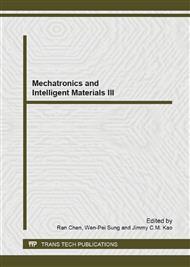p.1443
p.1450
p.1454
p.1458
p.1462
p.1468
p.1475
p.1479
p.1483
Numerical Study for a Bilayer Functionally Graded Cantilever Beam
Abstract:
A finite element analysis for a bilayer functionally graded cantilever beam is developed. The elastic modulus of each graded layer of the beam varies with the thickness as an arbitrary function respectively. The graded function of modulus can be dealt with easily by using MSC.Marc analysis code, which can increase the efficiency of calculation. By comparing finite element method (FEM) results with theory results, it can be found that the 8 node 2nd order element is more precise than the 4 node linear element, due to the former could eliminate the shear locking phenomenon effectively. Comparing to the method of equivalent coincident nodes, the forced displacement coupling on the perfect bonded interface is more appropriate. Finally, it is also shown that the results of finite element analysis are more rational than the theory results around the ends of the beam.
Info:
Periodical:
Pages:
1462-1467
Citation:
Online since:
June 2013
Authors:
Price:
Сopyright:
© 2013 Trans Tech Publications Ltd. All Rights Reserved
Share:
Citation:


